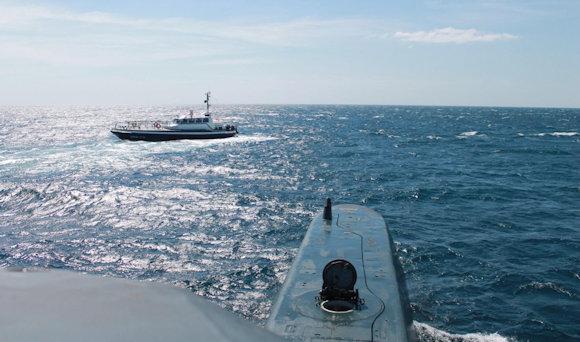The morning on board the Longobardo, proceeds following the schedule of scheduled operational / training events.
Before starting, we go down to the official square for a short breakfast, with coffee, biscuits, croissants and honey. There is no time for talk. You can not and do not have time to get distracted on board a boat. The "role" of a submarine's commander involves many responsibilities, (in primis) towards his crew and then towards his vehicle. It all depends on how his men will perform every maneuver according to his commands.
All always attentive to every command, even when the submarine navigates in surfacing or "periscope quota", Which is the altitude to which a submarine navigates underwater, close to the surface. Just enough to allow the periscope to get out and to scrutinize the surrounding scenery, without ever being seen. The Periscopic portion is a privileged observation point.
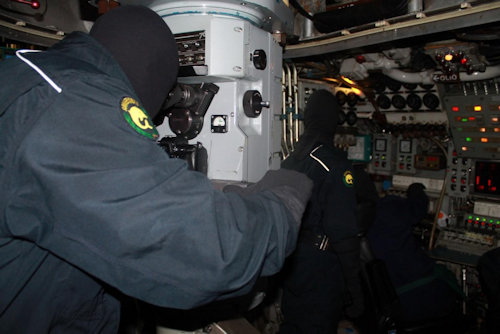 The training activity at sea begins with one "rapid immersion for the control of the structure and to train the guards ".
The training activity at sea begins with one "rapid immersion for the control of the structure and to train the guards ".
When you call the "dive role"It is possible, passing from surface navigation to navigation in immersion, to try out the possible diving dimensions. These are the "quotas" to which you can immerse yourself in operational activities, and then return to the safety quota, a quota that would allow you to quickly reach both the surface and the maximum operating quota.
When Commander Gelsomino orders the 160 dive quota, I feel like a protagonist in a movie! I find myself under the surface of the sea in who knows where in the Gulf of Taranto. It is one of the unique experience. I'm on board a submarine of the class Sauro. The commitment, the concentration, the professionalism of the whole crew of the S524, mixed with that insistent and persistent smell of diesel, put me on such an adrenaline to feel part of the group.
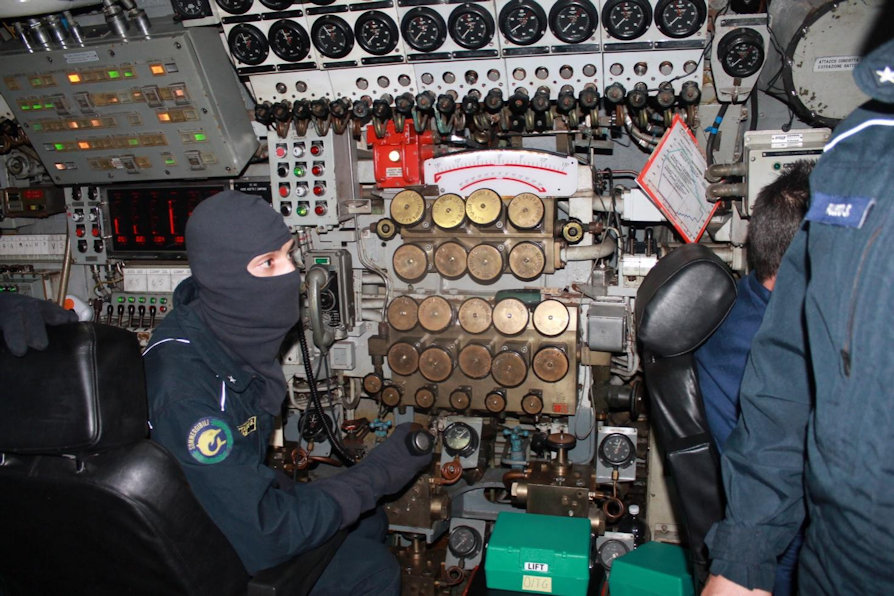
As soon as the "dive role - normal forward" is announced, the crew continues the training activity with a fire drill. For the precise, simulation of a "launch chamber" fire.
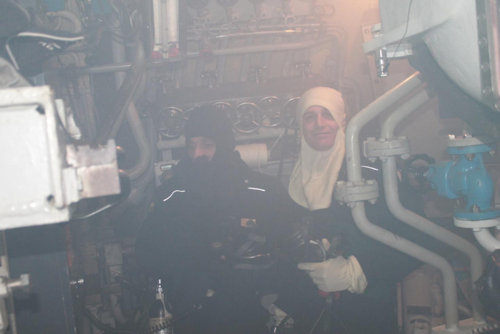 The entire crew is equipped with an "anti-flash kit" that he wears as soon as the fire principle has been announced.
The entire crew is equipped with an "anti-flash kit" that he wears as soon as the fire principle has been announced.
Meanwhile also the commander Gelsomino who is at the periscope of attack wears the (personal protective equipment DPI) Antiflash kit
The simulation in the launch room sees at first the intervention of the security guard, who failed to extinguish the fire with the first extinguisher available (there are several scattered throughout the boat).
In the meantime, the local concerned was evacuated, marking the orders, brief and concise, by means of ROC (Collective Orders Network) audible in all rooms of the boat. The guard staff was preparing to intervene, while the personnel free from the guard, who is in the launching room and then in the bow, must take to the cafeteria and be available to theofficial in 2 ^. The order is also given to stop ventilation and extraction, avoiding the uncontrolled spread of the fumes and removing the comburent from the fire.
Commander Gelsomino in the meantime orders quota 60 m.
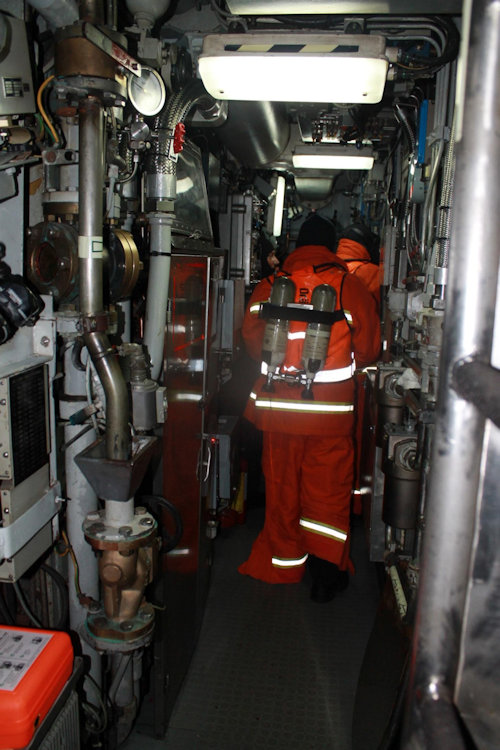 The "watertight bulkhead"(The 36 for the S524) that divides the hull into two sections is closed, allowing the crew to save themselves in an emergency by positioning themselves in the intact part of the boat. The bulkhead is also closed during the most delicate phases that a submarine is called to face, the dive, the ascent to the periscopic altitude and the emergence.
The "watertight bulkhead"(The 36 for the S524) that divides the hull into two sections is closed, allowing the crew to save themselves in an emergency by positioning themselves in the intact part of the boat. The bulkhead is also closed during the most delicate phases that a submarine is called to face, the dive, the ascent to the periscopic altitude and the emergence.
In the event that the fire occurred in a situation of normal navigation of the boat, it would be preferable to carry out an emergence maneuver to allow rapid air exchange. Given that a dive was being simulated with a unit on an occult mission, the emergency situation was dealt with quickly, trying to resume the operational mission shortly.
What worries during a fire aboard a submarine is the smoke which makes the air unbreathable. Without adequate countermeasures, the crew's survival would be compromised in a short time.
To eliminate the smoke, once at the periscopic altitude and with a high "snorkel barrel", the engines that draw in the air inside and through the silent they throw it out. At the same time from snorkel clean air is taken from outside and fed into the boat.
The commander Gelsomino, once periscope quota, in fact orders "start snorkel and ventilation".
The plant snorkel it allows the suction of air from the outside towards the inside of the unit, air necessary to start the combustion of the diesels that will be used, coupled to a dynamo, to recharge the batteries. It is also possible to recirculate the air inside the various rooms on board and to recharge the pressurized tanks essential for emptying the ballast tanks for emergence.
Lo snorkel, a large "metal tube", is a serious threat both because it exposes to enemy radars, and because it leaves a visible trail to anti-submarine planes. For these factors, the charging times of the batteries are carefully programmed.
On board, meanwhile, proceeds on fume evacuation plan. It requires the intervention of the "second team" among which the sub-class of third-class electrician Valeria Fedele, a young submariner. The team, using the air analysis kit, must monitor the air quality in the various rooms, making sure that no toxic gases or explosive agents are present.
After a series of communications between the local maneuver and the second team, communicating the complete absence of smoke and the breathable air, we declare the premises accessible. The 36 bulkhead is reopened.
 The exercise ended successfully and quickly, as per the manual. No major damage has been recorded, normal operating activity can be resumed.
The exercise ended successfully and quickly, as per the manual. No major damage has been recorded, normal operating activity can be resumed.
The Submarine First Lombard it is the first submarine of the IV series of the class Sauro, just "23 years" of navigation, has a propulsion apparatus consisting of an electric motor and the electric apparatus consists of 3 diesel groups, with battery and accumulators.
The armament consists of 6 torpedoes stored in 6 respective launch tubes.
Its dimensions allow for the distribution and optimization of interior spaces with considerable improvements, both in terms of operating capacity and on-board living conditions, compared to the predetermined classes.
From an operational point of view it is placed among the conventional type units (SSK) to fully satisfy the control and defense tasks of the maritime areas of interest of the Italian Navy.
The Italian Navy is equipped with highly skilled and specialized crews in the field of competence, as well as "never obsolete" but always efficient and corresponding to operational needs.
Even for the Longobardo, the combat system and the platform have undergone a "careful" modernization, such as to adapt it to modern mission profiles.
Il LongobardoLike all boats in line, in addition to maintaining the traditional ability to prevent or prevent hostile actions against our territory, it contributes powerfully to the control of Maritime Dimension, which nowadays also develops through operations such as the control of trafficking in migrants, drugs, smuggling and terrorism.


